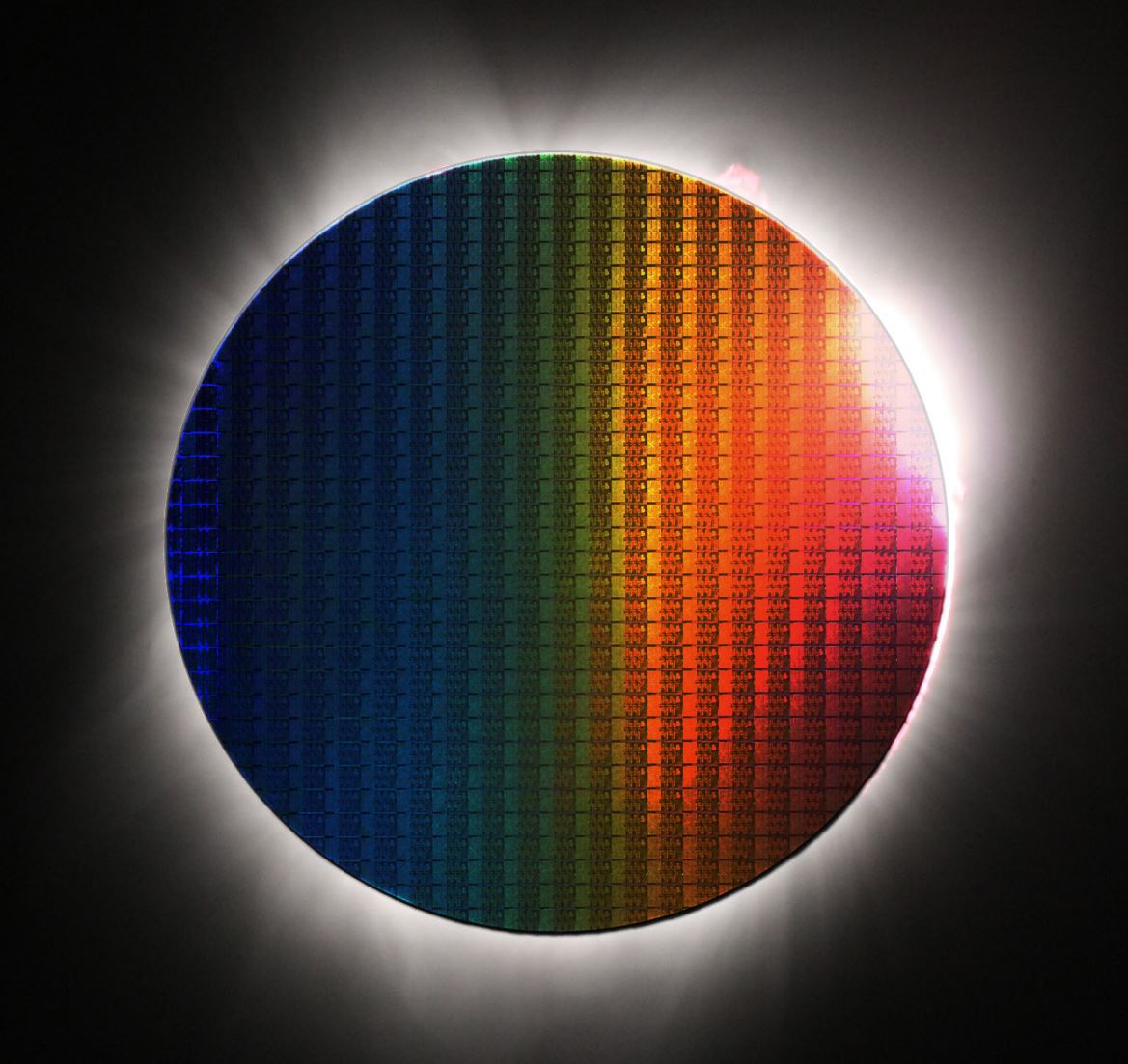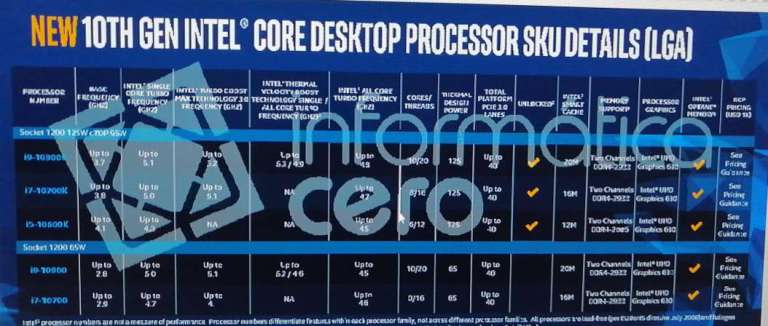Comet Lake to Allegedly Feature 10 Cores With up to 5.3GHz Thermal Velocity Boost

A new flood of leaks has flowed onto the net, so it increasingly looks like Intel will launch its 10th-Gen Core CPUs for the desktop, codenamed Comet Lake, at CES in early January. Most notably, according to the latest leaked information, the i9-10900K will feature 10-cores with a maximum “velocity boost” of 5.3GHz. The new chips should also mark the debut of the new 400-Series chipset.
Intel launched the 14nm Comet Lake-U for laptops in August, and it finally appears that the desktop will follow soon. Informatica Cero got hold of a purported list of the upcoming Comet Lake processors, while VideoCardz got ahold of a few additional slides. As with all leaked info, we have to approach these with the requisite suspicion. Also, be aware that pre-official specifications can also change at the official launch, though if true, they should give us a good idea of how the 10th-Gen processors will stack up.
Intel 10th-Gen K-Series Processors

According to Informatica's slides, the K-series of overclockable CPUs all have a 125W TDP, HyperThreading, UHD Graphics 630 and support for DDR4-2933 and 40 total platform PCIe 3.0 lanes. The slides also point to enhanced core and memory overclocking support and ‘Active Core Group Tuning.’ Other notable listings include Intel Rapid Store Technology (Likely IRST), and Wi-Fi 6 and 2.5G Ethernet support.
Logically, the Core i9-10900K would succeed the i9-9900KS. It features 10 cores and 20 MB of cache and has a base frequency of 3.7GHz, but this is improved via a new boost technology for the desktop. The single-core turbo frequency is listed at 5.1GHz, but this is extended to 5.2GHz with Turbo Boost Max Technology 3.0, and further improved to 5.3GHz with Thermal Velocity Boost (TVB), which has now apparently expanded from the mobile segment to the desktop. If intel sticks to the same tactic it used for the mobile space, the TVB opportunistic boost will kick in when the processor falls below a 50C temperature threshold, so much like the standard TurboBoost frequencies, it won't be guaranteed in all conditions. The slides also list the all-core turbo at 4.9GHz.
The i9-10900K is the only processor listed with support for Thermal Velocity Boost, while the i7-10700K also supports turbo Boost Max 3.0. It has eight cores at 3.8GHz with a maximum boost frequency of 5.1GHz for one core and 4.7GHz for all cores.
Thirdly, the i5-10600K is listed with six cores at 4.1GHz with a turbo speed of 4.5GHz and 4.8GHz for one core.
The regular SKUs have a TDP of 65W.
Get Tom's Hardware's best news and in-depth reviews, straight to your inbox.
| Core SKU | Cores / Threads | Base Clock (GHz) | Single Core Turboo (GHz) | Thermal Velocity Boost 1C/8C (GHz) | Max Turbo 3.0 (GHz) | All Core Turbo (GHz) | TDP (W) |
| i9-10900K | 10/20 | 3.7 | 5.1 | 5.3/4.9 | 5.2 | 4.8 | 125 |
| i9-10900 | 10/20 | 2.8 | 5.0 | 5.1/4.6 | 5.1 | 4.5 | 65 |
| i7-10700K | 8/16 | 3.8 | 4.7 | Row 3 - Cell 4 | 5.1 | 4.7 | 125 |
| i7-10700 | 8/16 | 2.9 | 4.8 | Row 4 - Cell 4 | 4.8 | 4.6 | 65 |
| i5-10600K | 6/12 | 4.1 | 4.8 | Row 5 - Cell 4 | Row 5 - Cell 5 | 4.5 | 125 |
| i5-10600 | 6/12 | 3.3 | 4.8 | Row 6 - Cell 4 | Row 6 - Cell 5 | 4.4 | 65 |
| i5-10500 | 6/12 | 3.1 | 4.5 | Row 7 - Cell 4 | Row 7 - Cell 5 | 4.2 | 65 |
| i5-10400 | 6/12 | 2.9 | 4.3 | Row 8 - Cell 4 | Row 8 - Cell 5 | 4.0 | 65 |
| i3-10320 | 4/8 | 3.8 | 4.6 | Row 9 - Cell 4 | Row 9 - Cell 5 | 4.4 | 65 |
| i3-10300 | 4/8 | 3.7 | 4.4 | Row 10 - Cell 4 | Row 10 - Cell 5 | 4.2 | 65 |
| i3-10100 | 4/8 | 3.6 | 4.3 | Row 11 - Cell 4 | Row 11 - Cell 5 | 4.1 | 65 |
F-Series

Meanwhile, on Chinese forum Baidu Tieba, images have emerged of supposed Comet Lake engineering samples, as well as information about the Comet Lake F-series. As a quick refresher, Intel’s F-Series desktop processors come with disabled integrated graphics. These models debuted with Coffee Lake last year in the wake of the company’s 14nm shortages.
However, the information seems preliminary as the table says the processors support DDR4-3200, as opposed to the DDR4-2933 in Intel’s slides. It also mentions an overclockable Core i3-10350K, which is also absent from Informatica Cero’s information.
The F-series will purportedly consist of three Core i9 SKUs with 10 cores: The i9-10900KF has a TDP of 105W listed with base/boost clocks of 3.4-5.2GHz. The non-K SKU drops those frequencies by 100-200MHz while the TDP drops to 95W. Thirdly, the i9-10800F has a base clock of 2.7GHz and turbo of 5GHz within its 65W TDP.
The clock is ticking down to CES 2020, so we'll soon know if the new rumors are accurate. Stay tuned.
| Core SKU | Cores / Threads | Base Clock (GHz) | Boost Clock (GHz) | TDP (W) |
| i9-10900KF | 10/20 | 3.4 | 5.2 | 105 |
| i9-10900F | 10/20 | 3.2 | 5.1 | 95 |
| i9-10800F | 10/20 | 2.7 | 5 | 65 |
-
Gurg AMD CTO Mark Papermaster: "you can't rely on that frequency bump from every new semiconductor node."Reply
Evidently no one told Intel they couldn't show frequency increases with each new chip advance. -
supremelaw Reply"40 total platform PCIe 3.0 lanes"
No PCIe 4.0 support with the "latest/greatest" chipset?
Isn't PCIe 4.0 the current standard?
What am I missing here, please? -
TJ Hooker Reply
This isn't a new node, so I don't see how that quote is relevant.Gurg said:AMD CTO Mark Papermaster: "you can't rely on that frequency bump from every new semiconductor node."
Evidently no one told Intel they couldn't show frequency increases with each new chip advance. -
setx Wow, "new" processors with "new" chipset again!Reply
Surely it's due to support of new feaures like PCI-E 4... not. -
TJ Hooker Reply
I guess they figured there was no point in making the chipset PCIe 4.0 when the link to the CPU would still only be 3.0. And the CPU lanes are still 3.0 because this is another rehash of the same architecture/node they've been on since Skylake, which is why there haven't really been any new features introduced since then other than higher clock speeds and more cores.supremelaw said:No PCIe 4.0 support with the "latest/greatest" chipset?
Isn't PCIe 4.0 the current standard?
What am I missing here, please? -
ingtar33 Skylake refresh no. 5.Reply
Amazing. there were 5 cpus in the "core i" infrastructure before skylake. since skylake all we've got were skylake+ more clock speed and cores. How is this innovation? Shouldn't intel be ashamed of themselves? Even more hilarious Skylake is technically a revision of broadwell, though I'll give intel some credit on this revision as they basically redid the memory infrastructure between broadwell and skylake. they haven't made any significant renovations since that memory infrastructure revision.
I'd make a joke about those 9000 series piledrivers (piledriver + more clock speed) however even AMD was ashamed of this move and dropped the idea after the first try. Intel's gone to this well 5 times now. -
Gurg Reply
When I next upgrade, I'll want PCIe4 , however the TH results of the Patriot Viper VP4100 M.2 NMVe review vs top PCIe3 NVMe were pretty underwhelming. Not what would hope given the pretty dramatic gains from HD to SSD to NVMe .supremelaw said:No PCIe 4.0 support with the "latest/greatest" chipset?
Isn't PCIe 4.0 the current standard?
What am I missing here, please?
Maybe PCIe4 will show more with graphic cards eventually, but are Nvidia and AMD going to market new gen graphic cards only to the limited number of early adopters? -
Gurg Reply
Intel picked up another 6% increase in just frequency, and it will take actual reviews to determine if there are any other architectural features increasing performance in non-workstation uses. Not bad for an incremental change which will replace but not come at a significant price increase from 9000 series. Enough to upgrade from a 9000 series CPU----obviously not.TJ Hooker said:This isn't a new node, so I don't see how that quote is relevant. -
Co BIY Replyingtar33 said:Shouldn't intel be ashamed of themselves?
They are selling everything they can make! They are even able to sell their "seconds" for near full value.
They have near record revenues, matching profits and retook the lead as the worlds largest semiconductor manufacturer.
I think they are probably proud rather than ashamed.
Gaming processors are not where the largest future profits are going to be and are not the focus of the biggest innovations and R&D efforts. -
BaRoMeTrIc Reply
pcie 4.0 only matters for gen 4 nvme, and gen 4 gpus that have low vram buffers. So unless you really need a gen 4 nvme, which i doubt you do unless you're using it as a file transfer cache across a multiple 10gbe nics, or you plan on buying a 4gb version of the 5500xt, 5400xt, pcie gen 4 is nice but not necessary at this point in time.supremelaw said:No PCIe 4.0 support with the "latest/greatest" chipset?
Isn't PCIe 4.0 the current standard?
What am I missing here, please?